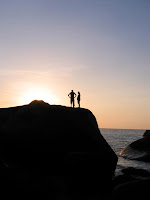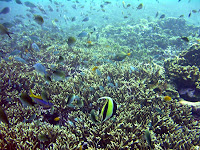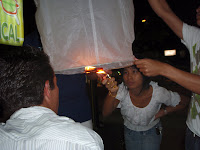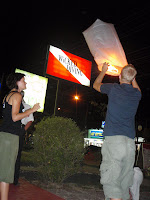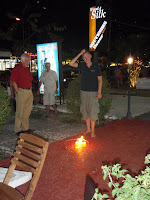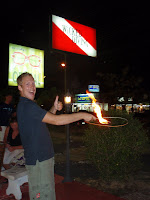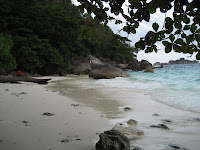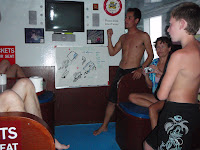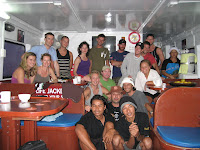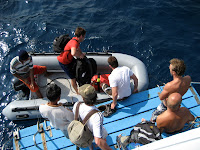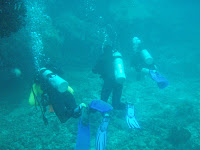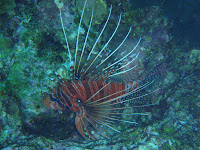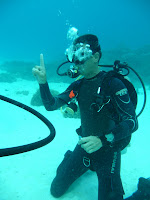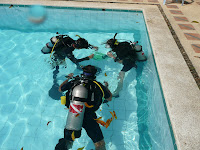Guidelines for safe diving with sharks
Diving with sharks is always an electric experience. It affords a uniquely intimate interaction with one of the sea’s most beautiful, elusive and charismatic forms of wildlife. But it is also an experience fraught with potential danger.
Each year, increasing numbers of recreational divers seek out opportunities to swim in the company of sharks. For some divers, the encounter represents an exciting photo opportunity, for others, a rare chance to meet a totemic creature face-to-face. It is difficult to know what a shark makes of such encounters, but it’s probably safe to say that the animal imagines no deeply spiritual connection between itself and its human admirers. That a shark is an alien creature that has the capability of inflicting serious injury or even death is part of the thrill. But one should not allow excitement to cloud his or her judgment. When visiting a shark in its liquid habitat, the onus is on us to behave appropriately. It is therefore very important that divers understand how to behave appropriately when swimming with sharks.
Below are a few tips on how one may best behave while diving in the company of sharks. These tips are based largely on my shark diving experience to date — thousands of dives with about 40 species of sharks in many locations around the globe and under a wide variety of diving conditions. This advice is offered in good faith toward the goal that it will help make your shark encounters safer and more enjoyable. However, it must be borne in mind that sharks are potentially dangerous wild animals that, despite long experience with them, remain very difficult to predict accurately. Therefore, the author and publisher of this book accept no responsibility whatever for those who choose to dive with sharks, regardless of whether or not they follow the advice presented here. If you choose to dive with sharks, you do so entirely at your own risk. That said, I hope all your shark encounters are pleasant ones.
* Understand and respect the environment. Learn what kinds of sharks you are likely to encounter in the area in which you plan to dive and know something of what to expect of each species’ behaviour. Bear in mind that maintaining diver safety becomes significantly more difficult with decreasing visibility (such as at night or in turbid water) and with increasing depth, current, task loading (such as carrying an underwater camera, speargun, or other equipment) and number of sharks. Never allow yourself to forget that the ocean itself is far more dangerous than any shark. Know your own limitations, and dive within them. Discuss dive logistics and contingency plans (hand signals, site analysis, entry and exit considerations, separation procedures, etc.) with your dive buddy before you enter the water.
* Enter the water quietly. If you spot a shark from the surface and choose to dive with it, enter the water quietly, using a controlled seated entry rather than a giant stride entry — not only are you less likely to frighten away any nearby shark, but also less likely to elicit a defensive attack. I have seen sharks react with great excitement to the commotion caused by a spectacular, noisy entry. In such an excited state, a shark can become dangerous in an instant.
* Behave like a well-mannered ‘guest’. Remember that you are a visitor in the shark’s living room. Let any shark you encounter approach and investigate you on its own terms. Do not chase, corner, grab, knife, spear, or touch the shark in any way; it is a wild animal that will defend itself if it perceives itself to be threatened. In all likelihood, if you do behave in a way that seems threatening to it, the shark will simply swim away rather than snap at or bite you — but it’s wisest to not take that chance or otherwise force the issue.
* If you want a shark to approach, avoid staring directly at it. In my experience, sharks are very aware of a diver’s eyes and seem to dislike being stared at as much as you or I do. Instead, watch it from ‘the corner of your eyes’. For your own safety, however, it is important that you do not loose sight of the shark while it is in your immediate vicinity. Remain vigilant for several minutes after the shark has apparently left, to be sure that it has, in fact, gone.
* Keep Still. During your encounter with a shark, remain motionless — preferably on or near the bottom. Try to become a non-threatening ‘part’ of the natural bottom topography. Large or rapid movements on the part of a diver often frightens a shark into fleeing and may startle it into defensive attack.
* Reduce your vertical profile in the water. Crouch down on or near the bottom or orient yourself horizontally in the water column — sharks often seem more unnerved by height than length, perhaps because the vast majority of creatures it encounters are longest horizontally, in the direction of travel.
* Avoid clustering with other divers. Sharks often seem to perceive tightly packed groups of divers as a single, large, and altogether frightening super-organism). Remain close enough to your buddy to maintain safety, but relatively far away from other such buddy pairs. Leave solo diving with sharks to the professionals.
* Be ‘interesting’. To prolong your encounter, take advantage of the shark’s natural curiosity. Try humming quietly into your regulator. Almost any tune with a simple but not-too-regular rhythm works pretty well — I’ve had good results with “Waltzing Matilda”, but the theme from “Gilligan’s Island” may be more to your tastes. (If you try this, let me know how it works out). Or try clinking two rocks together or clanging the butt of your dive knife against your scuba tank — these simple techniques are sometimes quite successful in luring a curious shark closer to investigate. If you have a brightly-coloured camera housing or reef gloves, they may also help pique a shark’s curiosity — but do not attempt to gesture while wearing such gloves: they may look edible to a shark.
* Do not use bait or otherwise attempt to feed a shark while underwater. Feeding contexts radically change the character of a shark’s investigative behaviour, and may lure other sharks, adding a competitive ‘wild card’ factor to the mix. Under such conditions, a shark encounter can change from wonderful and serene to downright dangerous in a fraction of a heartbeat. Leave shark feeding and working with baited sharks to the professionals.
* Observe and respond to the shark’s behavior. If a shark appears excited or agitated — exhibiting quick, jerky movements; pectoral fins held stiffly downward; abrupt change in swimming style; overall increase in muscular tension — or otherwise begins to swim in an erratic manner, leave the water immediately (following the guidelines outlined above). In all likelihood, by increasing the distance between you and the shark, it will relax somewhat and either make good its escape or return to its former, more languid cruising style. It may be relatively safe to remain in the water after that, but prudence dictates a slow but efficient exit from the water (again, following the guidelines above).
* Be aware of the behavior of fishes and other creatures in the immediate area: if they suddenly dive for cover, appear to behave erratically or in an agitated manner, leave the water immediately (following the basic guidelines outlined above). Trust your diver instincts — if something just doesn’t ‘feel’ right about the situation, leave the water immediately.
* Leave the water quietly and efficiently. If you must surface while a shark is in your immediate vicinity — due, for example, to low air supply — move slowly and deliberately, never loosing sight of the shark. Swim directly to your pre-planned exit site. Avoid a long surface swim, which is tiring and may leave you vulnerable to attack from below; when you arrive at your exit point (boat, dock, beach, whatever), do not dawdle — exit the water smoothly but efficiently.
Above all, enjoy the experience. You will almost certainly remember the encounter long after the shark has forgotten you.
Safe diving.
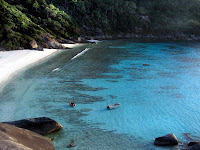 Donald Duck bay is not known as the most exciting of dives sites, but does feature some really great safe options for the diver and snorkeler alike. Frequent sightings of Turtles and Moray Eels make this a great site to learn more about the Similan Islands.
Donald Duck bay is not known as the most exciting of dives sites, but does feature some really great safe options for the diver and snorkeler alike. Frequent sightings of Turtles and Moray Eels make this a great site to learn more about the Similan Islands. 